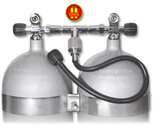Hey all,
Started some DSAT tec training the other weekend and all went well with the big exception of the skill whereby I had to turn off my right valve, turn it on, turn off my isolator, back on and then turn off my left valve and turn it back on... why did I have trouble... cause firstly, I am not as flexible as I was 30 years ago and secondly my trilaminate does not stretch where you need it.
So here I am looking at this months divelog magazine and open it to an add for Drager compressors and the picture has a tec diver with his tanks upside down. Now I know that this goes against the grain of having a standard rig setup, but having the valves at my butt make it dead easy to do the aformentioned skill.
No doubt this would be shunned by my instructor but would be curious as to the general concensus out there in user land.
Cheers
Rainsey
Started some DSAT tec training the other weekend and all went well with the big exception of the skill whereby I had to turn off my right valve, turn it on, turn off my isolator, back on and then turn off my left valve and turn it back on... why did I have trouble... cause firstly, I am not as flexible as I was 30 years ago and secondly my trilaminate does not stretch where you need it.

So here I am looking at this months divelog magazine and open it to an add for Drager compressors and the picture has a tec diver with his tanks upside down. Now I know that this goes against the grain of having a standard rig setup, but having the valves at my butt make it dead easy to do the aformentioned skill.
No doubt this would be shunned by my instructor but would be curious as to the general concensus out there in user land.
Cheers
Rainsey






